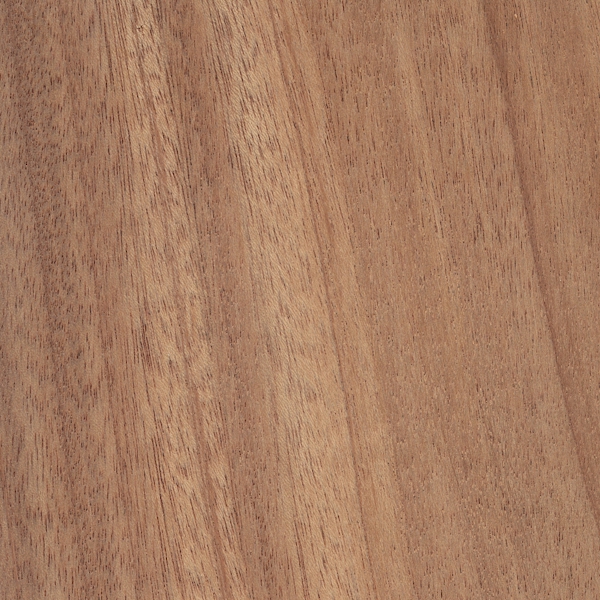
African Mahogany
Color/Appearance: Heartwood color is variable, ranging from a very pale pink to a deeper reddish brown, sometimes with streaks of medium to dark reddish brown. Color tends to darken with age. Quartersawn surfaces can also exhibit a ribbon-stripe appearance.
Grain/Texture: Grain is straight to interlocked, with a medium to coarse texture. Good natural luster with a light-refracting optical phenomenon known as chatoyancy.
Endgrain: Diffuse-porous; large to very large pores, very few; solitary and radial multiples; orange/brown deposits occasionally present; growth rings usually indistinct, though sometimes distinct due to terminal parenchyma; rays medium to wide, fairly close spacing; parenchyma scanty to vasicentric, and occasionally marginal (not typical forKhaya spp.).
Rot Resistance: Rated as moderately durable; moderate to poor insect/borer resistance.
Workability: Easy to work, glue, and finish. Tearout can sometimes be a problem if the grain is interlocked.
Odor: No characteristic odor.
Allergies/Toxicity: Although severe reactions are quite uncommon, African Mahogany has been reported as asensitizer. Usually most common reactions simply include eye and skin irritation. See the articles Wood Allergies and Toxicity and Wood Dust Safety for more information.
Comments: Comprised of a handful of species from the Khaya genus, all of which are native to Africa. Sometimes lacks the deeper reddish brown color and durability that is common for true mahogany in the Swietenia genus. Botanically, Khaya is a part of the Meliaceæ family, which not only includes mahoganies, but also Sapele(Entandrophragma cylindricum), and a host of other commercial species. Considered to be a valid substitute forHonduran Mahogany (Swietenia macrophylla), otherwise known as “Genuine Mahogany.”

Birdseye Maple
Birdseye Maple is not technically a distinct species of Maple, but rather, it’s a figure that’s occasionally found in Acer saccharum (Sugar Maple) trees. It’s named “birdseye” (sometimes simply written out as: Bird’s Eye Maple) because the figure resembles small bird’s eyes. The figure is reportedly caused by unfavorable growing conditions for the tree. The Sugar Maple attempts to start numerous new buds to get more sunlight, but with poor growing conditions the new shoots are aborted, and afterward a number of tiny knots remain. Birdseye Maple is frequently sold in veneer form, but solid lumber is available as well. Being tiny knots, the birdseye figure is most noticeable and pronounced on flatsawn pieces of lumber.
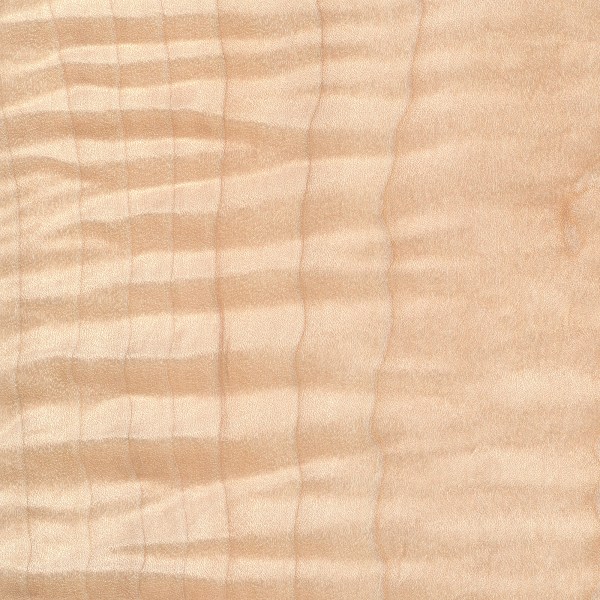
Curly Maple
Curly Maple is not actually a species, but simply a description of a figure in the grain—it occurs most often in soft maples, but is also seen in hard maples. It is so called because the ripples in the grain pattern create a three dimensional effect that appears as if the grain has “curled” along the length of the board. Other names for this phenomenon are: tiger maple, fiddleback maple, (in reference to curly maple’s historic use for the backs and sides of violins), or flamed maple. Unlike quilted maple, curly maple is most pronounced when the board is quartersawn, and the curls usually become much less pronounced or absent in flatsawn boards. Hence, on wide boards where the grain tends to be close to vertical (quartersawn) near the edges and horizontal (flatsawn) in the center, the curly pattern will be most evident on the edges of the board, with the figure diminishing in the center. It is not completely clear what environmental conditions (if any) cause this phenomenon, but there are different grades of curly maple, which greatly affect its price. Ideally, the criteria for determining value is based upon: color (both uniformity and lightness—whiter is preferred), frequency of the curls (tight, closely-spaced curls are preferred), and intensity (more depth is preferred). Prices can range from just slightly more expensive than regular soft maple for lower grades of curly maple, to triple, quadruple, or higher for prices of the highest grades. But in general, higher grades of curly maple tend to be less expensive than quilted maple, and offer an economical solution for a “figured” hardwood.
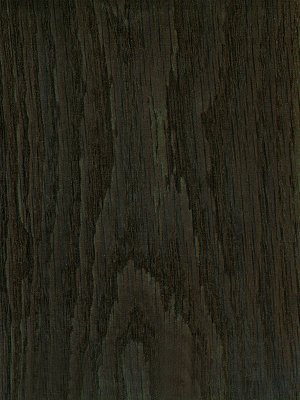
Fumed Spessart Oak
Fumed Oak is not actually a species of oak, but simply is a wood finishing process that darkens wood and brings out the grain pattern. It consists of exposing the wood to fumes from a strong aqueous solution of ammonium hydroxide which reacts with the tannins in the wood. The process works best on white oak because of the high tannin content of this wood. Fumed oak is also called smoked oak. Other species may also be fumed, but usually will not darken as much as white oak.
Color/Appearance: Has a medium yellowish-brown color, though there can be a fair amount of variation in color.
Grain/Texture: Has medium-to-large pores and a fairly coarse grain. May have irregular or interlocked grain depending on growing conditions of the tree.
Endgrain: Diffuse-porous; large to very large pores, very few; solitary and radial multiples; orange/brown deposits occasionally present; growth rings usually indistinct, though sometimes distinct due to terminal parenchyma; rays medium to wide, fairly close spacing; parenchyma scanty to vasicentric, and occasionally marginal (not typical forKhaya spp.).
Rot Resistance: Sessile Oak has been rated as having very good resistance to decay, and is commonly used in boatbuilding applications.
Workability: Easy to glue, and takes stain and finishes very well.
Odor: Has a tell-tale smell that is common to most oaks. Most find it appealing.
Sustainability: This wood species is not listed in the CITES Appendices or on the IUCN Red List of Threatened Species.
Common Uses: Cabinetry, furniture, interior trim, flooring, boatbuilding, barrels, and veneer.
Comments:Sessile Oak falls into the white oak group, and shares many of the same traits as White Oak (Quercus alba). The species is nearly identical to English Oak (Quercus robor), and is used extensively for both interior and exterior building applications throughout Europe.
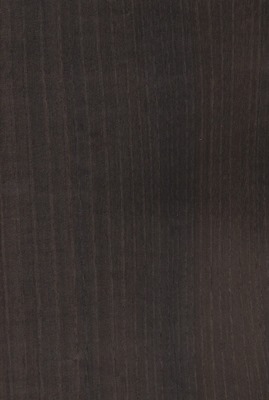
Fumed Chestnut
Fumed Chestnut is not actually a species of Chestnut, but simply is a wood finishing process that darkens wood and brings out the grain pattern. It consists of exposing the wood to fumes from a strong aqueous solution of ammonium hydroxide which reacts with the tannins in the wood. The process works great on Chestnut because of the high tannin content of this wood. Fumed Chestnut is sometimes called smoked Chestnut. Other species may also be fumed, but not all will not achieve that rich darkened color like the Chestnut.
Color/Appearance: Heartwood is a light to medium brown, darkening to a reddish brown with age. Narrow sapwood is well-defined and is pale white to light brown.
Grain/Texture: Grain is straight to spiral or interlocked. With a coarse, uneven texture.
Endgrain: Ring-porous; 2-4 rows of large, exclusively solitary earlywood pores, numerous small latewood pores in dendritic arrangement; tyloses common; growth rings distinct; rays not visible without lens; apotracheal parenchyma diffuse-in-aggregates (short lines between rays).
Rot Resistance: Rated as durable to very durable, though susceptible to insect attack.
Workability: Overall easy to work with both hand and machine tools. Chestnut splits easily, so care must be taken in nailing and screwing the wood. Due to its coarse texture, turning is mediocre. Glues, stains, and finishes well.
Odor: No characteristic odor.
Sustainability: This wood species is not listed in the CITES Appendices or on the IUCN Red List of Threatened Species.
Common Uses: Furniture, veneer, and carvings.
Comments: This tree is widely cultivated for the edible seeds which it produces.
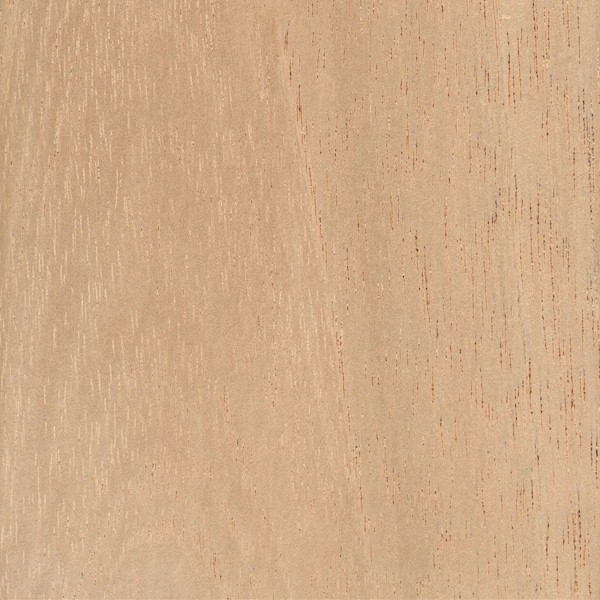
Spanish Cedar
Color/Appearance: Heartwood is a relatively uniform light pinkish to reddish brown; colors tend to darken with age. Random pockets of gum and natural oils are commonly present. Grain patterning and figure tends to be somewhat bland.
Grain/Texture: Grain is straight or shallowly interlocked. Medium texture and moderate natural luster.
Endgrain: Can range from ring-porous to diffuse-porous; medium-large earlywood pores, small-medium latewood pores; solitary and radial multiples of 2-3; mineral deposits (red gum) occasionally present; growth rings distinct due to terminal parenchyma in diffuse-porous samples, or lines of larger pores in ring-porous samples; rays usually visible without lens; parenchyma banded (terminal), apotracheal parenchyma diffuse-in-aggregates, paratracheal parenchyma vasicentric.
Rot Resistance: Spanish Cedar ranges from durable to moderately durable regarding decay resistance, and is also resistant to termite attack; the wood is also reported to have excellent weathering characteristics. Older, slower-growing trees from the wild tend to produce wood that is more durable than wood from younger, plantation-grown trees.
Workability: Spanish Cedar is easy to work with both hand and machine tools. However, due to its low density and softness, Spanish Cedar tends to leave fuzzy surfaces if not machined with sharp cutters; extra sanding up to finer grits may be required to obtain a smooth wood surface. Also, natural gum pockets can remain wet and may ooze out onto the surrounding surface, which can clog and gum up saw blades, and make finishing the wood a challenge.
Odor: Has a distinct, lingering, cedar-like scent; this characteristic of the wood makes it a favorite for cigar boxes.
Common Uses: Veneer, plywood, cabinetry, musical instruments, (flamenco and classical guitars), humidors, and boatbuilding.
Comments: A historically valuable Latin-American timber, Spanish Cedar has been exploited in many regions, and the species is now considered to be vulnerable according to the IUCN. It’s also listed on the CITES Appendix III for the countries of Brazil, Bolivia, Columbia, Guatemala, and Peru. (It’s listing in Appendix III simply means that the countries listed have voluntarily chosen to control the exporting of the wood, and have sought the cooperation of other countries to help in enforcing these restrictions.) Spanish Cedar may still be freely exported from other Latin American countries not listed in Appendix III. Not a true cedar, Spanish Cedar is actually more closely related to true Mahoganies (Swietenia and Khaya genera), as both are in the Meliaceae family. Density and mechanical properties can vary widely depending on country of origin and growing conditions; (specific gravity can vary from .30 to as high as .60 in some instances). Some of the wood available at present comes from plantations: where younger, faster-growing trees, produce wood that is lower in density, and paler in color than wood cut from trees taken from forests in the wild.
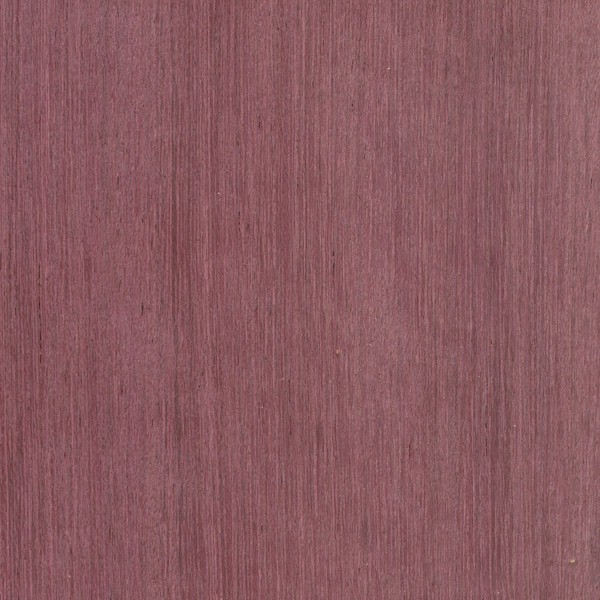
Purple Heart
Color/Appearance: When freshly cut the heartwood of Purpleheart is a dull grayish/purplish brown. Upon exposure the wood becomes a deeper eggplant purple. With further age and exposure to UV light, the wood becomes a dark brown with a hint of purple. This color-shift can be slowed and minimized by using a UV inhibiting finish on the wood. For more information, see the article Preventing Color Changes in Exotic Woods.
Grain/Texture: The grain is usually straight, but can also be wavy or irregular. Has a medium texture with good natural luster.
Endgrain: Diffuse-porous; medium to large pores, few; solitary and radial multiples; mineral deposits occasionally present; growth rings may be either distinct or indistinct depending on species and growing conditions; medium rays barely visible without lens, normal spacing; parenchyma winged, lozenge, confluent, unilateral, and occasionally marginal.
Rot Resistance: Purpleheart is rated as being very durable, and resists both decay and most insect attacks, though it has been reported to be susceptible to attack from marine borers.
Workability: Working with Purpleheart can present some unique challenges: if the wood is heated with dull tools, or if cutter speeds are too high, Purpleheart will exude a gummy resin that can clog tools and complicate the machining process. Depending on the grain orientation, can be difficult to plane without tearout. Purpleheart also has a moderate dulling effect on cutters.
Odor: Varies depending upon the species: most species have no characteristic odor, though some species can have a pungent scent.
Sustainability: This wood species is not listed in the CITES Appendices or on the IUCN Red List of Threatened Species.
Common Uses: Inlays/accent pieces, flooring, furniture, boatbuilding, heavy construction, and a variety of specialty wood items.
Comments: Sometimes called Amaranth, this colorful Latin American hardwood is tremendously popular for furniture and other designs that call for a unique splash of color. In addition to its coloration, Purpleheart has excellent strength properties, and can be used in applications where strength is important—a wood for both form and function.
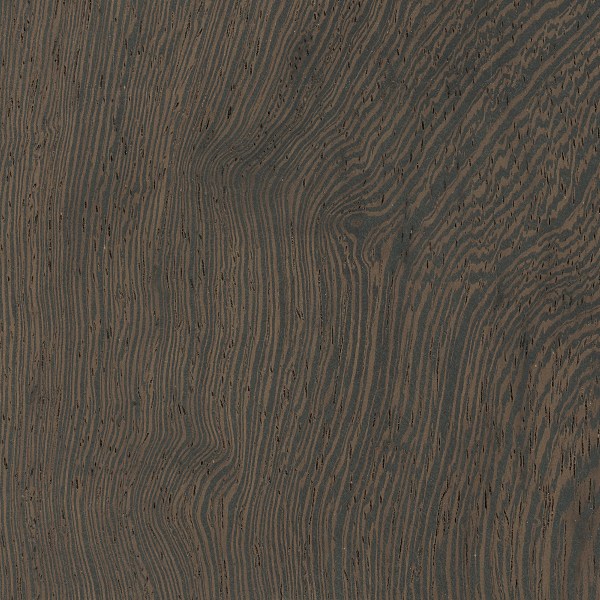
Wenge
Color/Appearance: Heartwood is medium brown, sometimes with a reddish or yellowish hue, with nearly black streaks. Upon application of a wood finish (particularly an oil finish) the wood can become nearly black.
Grain/Texture: Grain is straight, with a very coarse texture. Low natural luster.
Endgrain: Diffuse-porous; large to very large pores in no specific arrangement, very few; solitary and radial multiples of 2-3; dark brown mineral deposits occasionally present; medium rays not visible without lens, normal spacing; parenchyma vasicentric, confluent, with wide bands of parenchyma typically as thick as the pores.
Rot Resistance: Very durable, and resistant to termite attack.
Workability: Can be difficult to work with hand and machine tools. Blunts tool edges. Sands unevenly due to differences in density between light and dark areas. Very splintery—care must be used when handling unfinished wood with bare hands, as splinters have an increased risk of infection. Very large pores can be difficult to fill if a perfectly smooth/level finish is desired.
Odor: Wenge has a faint, slightly bitter scent when being worked.
Sustainability: This wood species is not listed in the CITES Appendices, but is on the IUCN Red List. It is listed as endangered due to a population reduction of over 50% in the past three generations, caused by a decline in its natural range, and exploitation.
Common Uses: Veneer, paneling, furniture, turned objects, and musical instruments.
Comments: Usually pronounced WHEN-gii or WHEN-ghay, the wood has excellent strength and hardness properties, and is also dark enough to be used as a substitute for ebony.
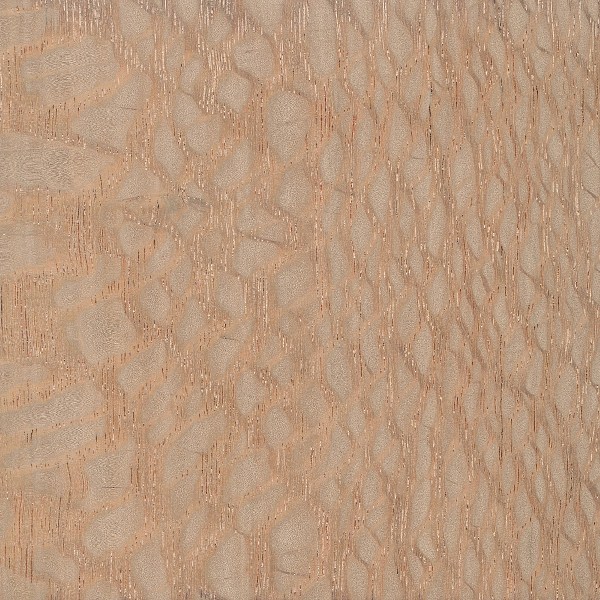
Lacewood
Color/Appearance: Has a very conspicuous flecking that gives this wood its namesake. The wood itself is a reddish brown with grey or light brown rays, which result in a lace pattern when quartersawn. Like other woods that exhibit the strongest figure in quartersawn pieces, (such as Sycamore), Lacewood has the most pronounced figure and displays the largest flecks when perfectly quartersawn; this is due to the wood’s wide medullary rays, whose layout can be seen the clearest when looking at the endgrain.
Grain/Texture: Has a fairly coarse and uneven texture due to the difference in densities between the regular wood tissue and the rays. The grain is usually straight.
Endgrain: Diffuse-porous; small to medium pores in tangential rows; solitary and tangential multiples of 2-3; deposits in heartwood occasionally present; growth rings indistinct; very wide rays easily visible without lens; parenchyma banded, diffuse-in-aggregates.
Rot Resistance: Lacewood is rated as non-durable and is also susceptible to insect attack.
Workability: Overall a fairly easy wood to work with, taking glues, stains, and finishes well; though there may be some difficulty in planing, with tearout occurring. Some species of lacewood can also have a moderate blunting effect on cutting edges.
Odor: No characteristic odor.
Sustainability: This wood species is not listed in the CITES Appendices or on the IUCN Red List of Threatened Species.
Common Uses: Veneer, cabinetry, fine furniture, musical instruments (guitars), and turned objects.
Comments: The name “Lacewood” is used very loosely and can be applied (and misapplied) to a number of different wood species. In its vaguest sense, the term “lacewood” is used to describe any wood that displays figuring that resembles lace. Attempts to identify a specific board macroscopically may be difficult. Two Australian species, Northern Silky Oak (Cardwellia sublimis), and Southern Silky Oak (Grevillea robusta) can both look very similar, and are sometimes sold as Australian Lacewood. Additionally, Leopardwood (Roupala spp.) looks similar, but tends to be slightly darker brown, and is significantly heavier.


